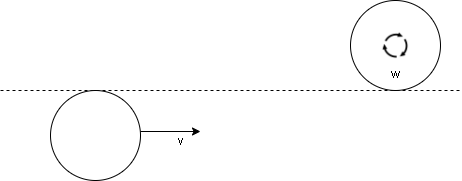
Answer
445.2k+ views
Hint: Angular velocity is the velocity which relates how fast the position of an object changes with respect to time. It shows how fast an object moves relative to another point. It is given that another disc is moving translationally with respect to the first one. An object is said to be in translational motion if they are moving in the same line.
Complete step by step solution:
Step I:
If they are colliding with each other, then they should be following the law of conservation of energy. Since when two objects collide, their velocity can change and energy can be transformed from one form to another but can not be destroyed. Both the discs will have a moment of inertia before and after the collision.
Step II:
Let \[I\] be the moment of inertia and \[\omega \]be the angular velocity before the collision.
Let \[{I^{'}}\]be the moment of inertia and \[{\omega ^{'}}\] be the angular velocity when they stick together.
In translational motion, the kinetic energy of the discs is \[\dfrac{1}{2}m{v^2}\].
Step III:
According to law of conservation of Energy,
Energy of discs before collision = Energy of discs after collision
\[\dfrac{1}{2}{\omega^2} + \dfrac{1}{2}m{v^2} = \dfrac{1}{2}{I^{'}}{\omega ^{{{'}^2}}}\]----(i)
Moment of Inertia is written as:
\[\Rightarrow I = m{r^2}\]and
Angular velocity is written as
\[\Rightarrow \omega = \dfrac{v}{r}\]
\[\Rightarrow v = \omega r\]
Step IV:
Substituting value of \[I\]and\[v\]in equation (i),
\[\Rightarrow \dfrac{1}{2}m{r^2}{\omega ^2} + m{r^2}{\omega ^2} = \dfrac{3}{2}m{r^2} \times 2\omega {'^2}\]
\[\Rightarrow \dfrac{{{\omega ^2}}}{2} + {\omega ^2} = 3\omega {'^2}\]
\[\Rightarrow \omega {'^2} = \dfrac{1}{2}{\omega ^2}\]
\[\Rightarrow \omega {'} = \dfrac{\omega }{{\sqrt 2 }}\]
\[\Rightarrow \omega ' = \dfrac{\omega }{{{2^2}}}\]
$\therefore$The angular velocity of the center of mass will be \[\dfrac{\omega }{{{2^2}}}\]. Hence, option D is the correct answer.
Note:
It is to be noticed that translational motion is not similar to linear motion. They both are different and are not to be mixed. Linear motion is a type of translational motion because in this motion the object moves in a straight line only. But in translational motion, the object can move in two or three dimensions also.
Complete step by step solution:
Step I:
If they are colliding with each other, then they should be following the law of conservation of energy. Since when two objects collide, their velocity can change and energy can be transformed from one form to another but can not be destroyed. Both the discs will have a moment of inertia before and after the collision.
Step II:
Let \[I\] be the moment of inertia and \[\omega \]be the angular velocity before the collision.
Let \[{I^{'}}\]be the moment of inertia and \[{\omega ^{'}}\] be the angular velocity when they stick together.
In translational motion, the kinetic energy of the discs is \[\dfrac{1}{2}m{v^2}\].
Step III:
According to law of conservation of Energy,
Energy of discs before collision = Energy of discs after collision
\[\dfrac{1}{2}{\omega^2} + \dfrac{1}{2}m{v^2} = \dfrac{1}{2}{I^{'}}{\omega ^{{{'}^2}}}\]----(i)
Moment of Inertia is written as:
\[\Rightarrow I = m{r^2}\]and
Angular velocity is written as
\[\Rightarrow \omega = \dfrac{v}{r}\]
\[\Rightarrow v = \omega r\]
Step IV:
Substituting value of \[I\]and\[v\]in equation (i),
\[\Rightarrow \dfrac{1}{2}m{r^2}{\omega ^2} + m{r^2}{\omega ^2} = \dfrac{3}{2}m{r^2} \times 2\omega {'^2}\]
\[\Rightarrow \dfrac{{{\omega ^2}}}{2} + {\omega ^2} = 3\omega {'^2}\]
\[\Rightarrow \omega {'^2} = \dfrac{1}{2}{\omega ^2}\]
\[\Rightarrow \omega {'} = \dfrac{\omega }{{\sqrt 2 }}\]
\[\Rightarrow \omega ' = \dfrac{\omega }{{{2^2}}}\]
$\therefore$The angular velocity of the center of mass will be \[\dfrac{\omega }{{{2^2}}}\]. Hence, option D is the correct answer.
Note:
It is to be noticed that translational motion is not similar to linear motion. They both are different and are not to be mixed. Linear motion is a type of translational motion because in this motion the object moves in a straight line only. But in translational motion, the object can move in two or three dimensions also.
Recently Updated Pages
How many sigma and pi bonds are present in HCequiv class 11 chemistry CBSE

Mark and label the given geoinformation on the outline class 11 social science CBSE

When people say No pun intended what does that mea class 8 english CBSE

Name the states which share their boundary with Indias class 9 social science CBSE

Give an account of the Northern Plains of India class 9 social science CBSE

Change the following sentences into negative and interrogative class 10 english CBSE




